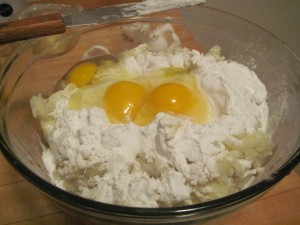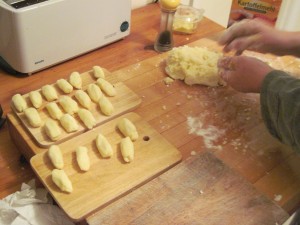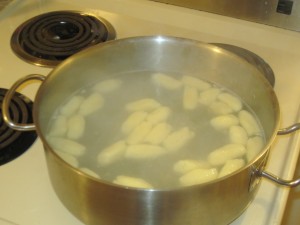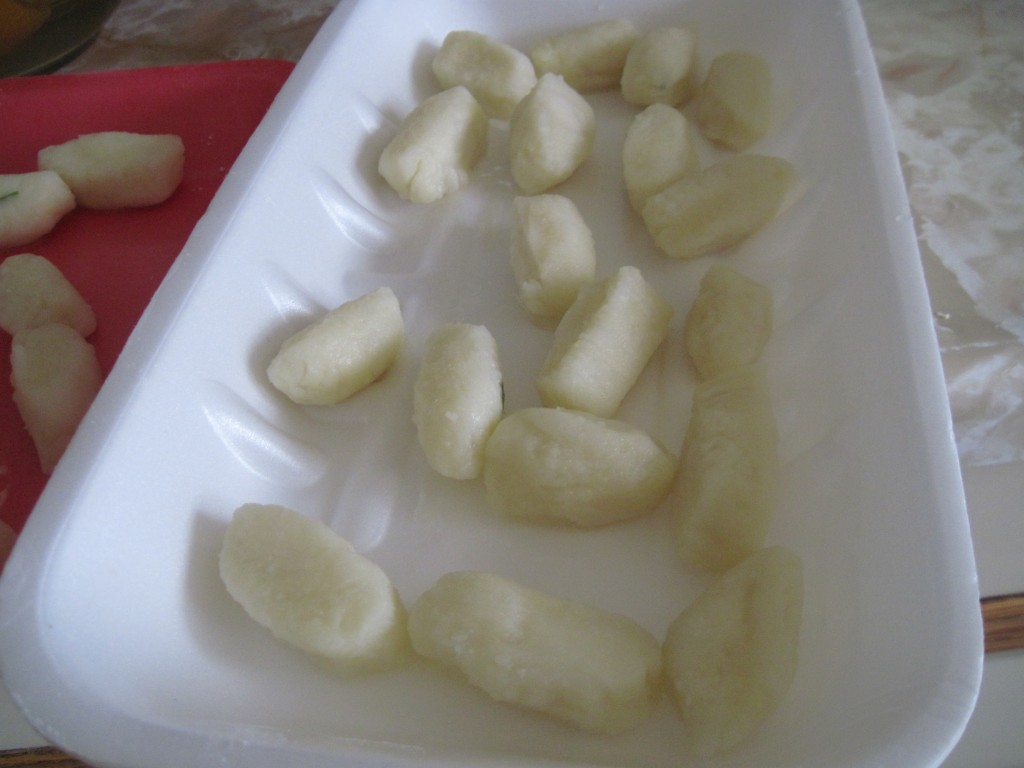Kluski Śląskie (Silesian Potato Dumplings) are usually prepared when you have some leftover mashed potatoes – but can be made ‘from scratch’, starting with real raw potatoes. In such case you should boil potatoes in salted water, mash them, and then measure the amounts to achieve the balance. Mashing is easier when potatoes are still hot..
Served as an accompaniment to meat (Goose, pork roasts..) with sauce, or as individual dish with sauce, with veggies, or bacon bits. The texture of these is much like regular potato dumplings (Kopytka, made with regular white flour, not the potato starch), but they are much more ‘rubbery’, and you must work the dough differently, forming each piece in your hands, instead of rolling the dough on the table surface.
Good candidates for freezing and reheating when needed. Before freezing you must pre-boil them (see below) and cool in a single layer on flat surface (large platter) so that they cool down without sticking to each other.
For 12 people as a side dish, you need
- 1500g of mashed potatoes (room temperature)
- 500 g potato starch – feel free to add more, if dough seems soft
- 3 eggs
I usually make a lot and freeze – unless some of it goes onto a dining table right away – the freezer and a very easy re-heat option make a single time effort lay out many times in the future. The portion above took me less than one hour to compose – and I have more 4-5 dinner sets ready..
- put the big pot filled with water on the stove, add some salt to water, bring it to boils as soon as possible
- place potatoes in a large mixing bowl
- drop in the egg(s), salt, and sprinkle over it sifted starch (potato flour)

- gently mix the stuff (I do it with potato masher, or the half-moon device used to crunch hard boiled eggs for egg salad).
- when somewhat mixed, take it onto the table surface and continue,. work gently, patiently folding and gathering rather than forcibly squashing it as you would with the regular pasta pastry
- when the dough looks uniform in texture, take out a chunk, form a little sample and be ready to use it as a tester for boiling –
- when the water is boiling, drop in your tester and observe – does it stay together while boiling, or is it falling apart? If falling apart, you need to add some flour to the dough and knead it (back to step (5) above..)
- scrape and wash your hands.
- brake off a small chunk of the dough; each chunk will make one dumpling; I take a generous tablespoon full as an approximate one-kluska-measure
- roll the dough in the palms of your hands, shape into an elongated piece (not longer that 2 inches (5 cm), and not fatter than 1 inch). set aside.

- Grab more dough, make more dumplings
- When water boiling, gently pick up your ready make pieces and immerse in boiling water.
- Stir the pot gently with the wooden spoon
- Now you can return to point 9, until the whole dough is gone, but must check the pot frequently.
- When dumplings start showing up at the surface of the water, they are ready for freezing (see noted above).

- Otherwise you let them boil (simmer) for a few minutes. Take one out to test for doneness (must taste cooked!).
- Out of the pot they will come quite sticky and will want to retain very close contact with their brothers and sisters. you prevent it by applying some greasy substance (oil? butter? melted bacon fat?..) or by placing them far from each other on a flat surface. the latter method must be used when kluski are to be frozen.

Kluski Śląskie have no eggs and much different shape. You made so called “Kluski ślaskie” you can eat in Gdańsk but not in Silesia.
Hi – you may very well be right. Can you help by suggesting a recipe close to the Silesian style? Would be grateful, i am sure.
Thank you